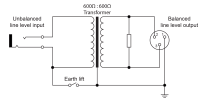boltrecords
Fractal Fanatic
Im noticing a difference in volume between when I use XLR out Left vs the 1/4" out Left. Is this always the case when using balanced vs unbalanced?
Both XLR and 1/4” outputs are fed identical signals, but they have different levels. A balanced signal is, by nature, 6 dB hotter than an identical unbalanced signal.For out1 the XLR and 1/4 outputs are identical, according to the manual (so the level is the same) - so if you're getting a difference in volume between those you have a cabling issue.
The 1/4” outputs are unbalanced. If you tell us where in the manual it says otherwise, I’ll report the error.Also, note that the 1/4" outputs are not unbalanced - they are all balanced (according to the manual).
I was looking at page 21 - which clearly says that the 1/4" are unbalanced! I must have been looking at the inputs! Apologies - will correct above ...Both XLR and 1/4” outputs are fed identical signals, but they have different levels. A balanced signal is, by nature, 6 dB hotter than an identical unbalanced signal.
The 1/4” outputs are unbalanced. If you tell us where in the manual it says otherwise, I’ll report the error.
No worries. Shit happens — and sometimes I'm the one taking the dump.I was looking at page 21 - which clearly says that the 1/4" are unbalanced! I must have been looking at the inputs! Apologies - will correct above ...
A balanced signal is, by nature, 6 dB hotter than an identical unbalanced signal.

The irony is that I thought they were unbalanced, but decided that I should check the manual first to be sure and was surprised to (incorrectly) read that they weren't!!No worries. Shit happens — and sometimes I'm the one taking the dump.
You're right. If you use a transformer to convert from balanced to unbalanced, you'll get pretty much the same signal level on both ends. That's how they make baluns, which are external devices for doing just that.My understanding - which is, admittedly, limited! (I am not an EE ..) - is that it would be true of a differential signal on a balanced line, and where the unbalanced signal is created by taking just one side of the differential signal and connecting the other to ground. But my understanding is that a balanced line need not necessarily be carrying a differential signal, and many devices have balanced and unbalanced outputs that are not created merely by connecting only half of the balanced output - for example, if the unbalanced output is created via transformer, can't it be done without a drop (like in the below)?
Asking in part because I'm thinking of building an interface for a live rig that, among other things, converts between balanced and unbalanced, and am trying to understand the best way to do it ...
View attachment 108178
